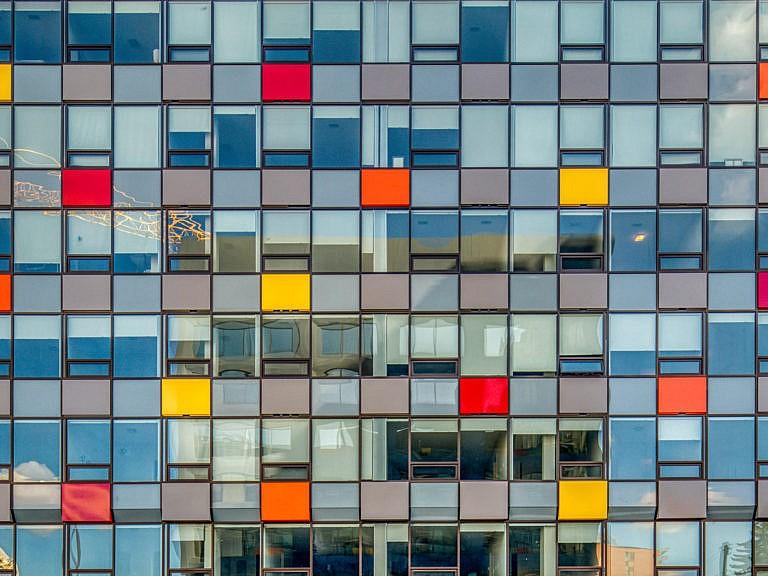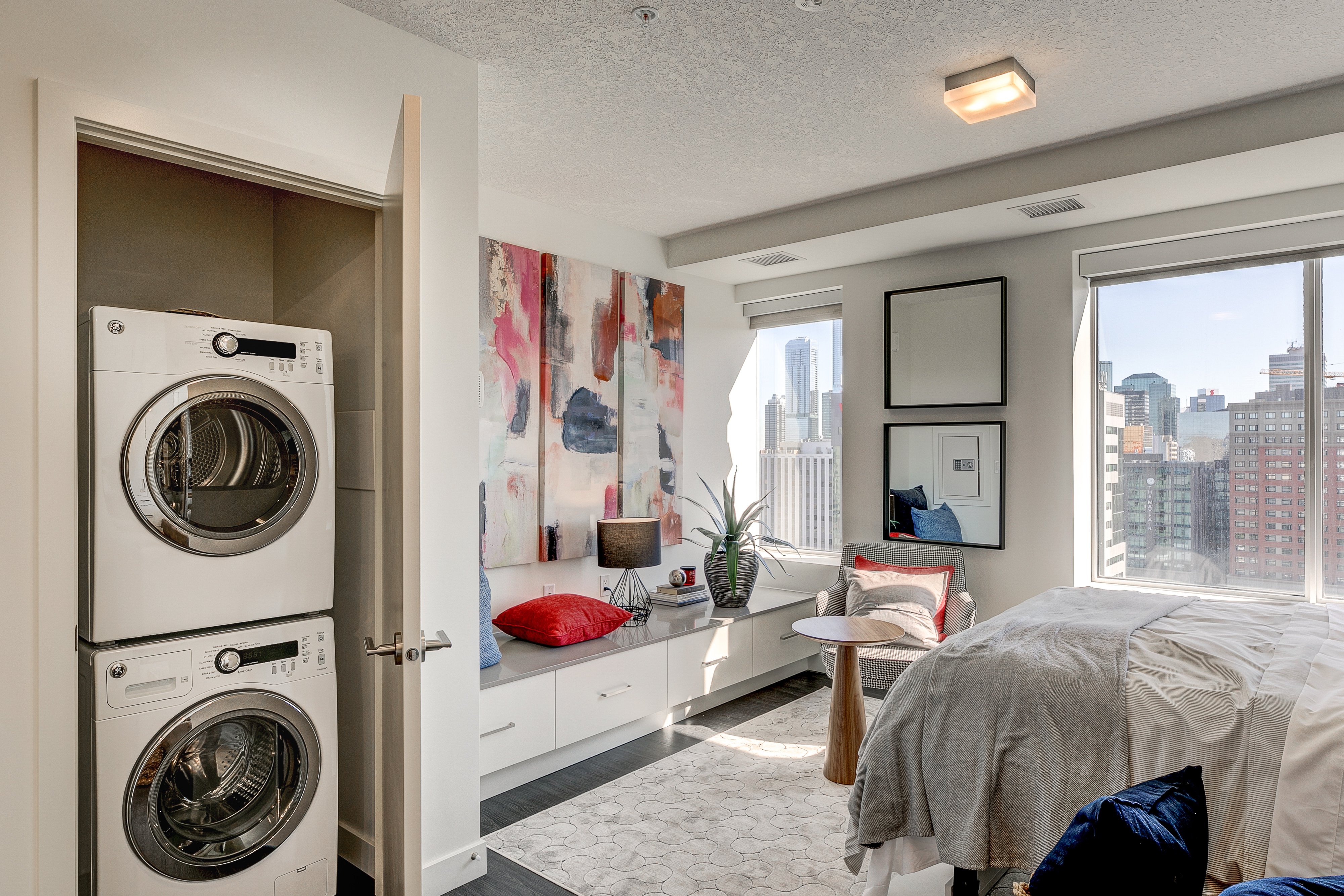How this Calgary company is transforming empty offices into housing units
“Frankly, we didn’t realize how beneficial these conversions would be until after we started”

The Cube building in downtown Calgary is one of four office conversions carried out by Strategic Group (Photos courtesy the company)
Share
Even as remote employees start returning to in-person work, Canada’s downtowns remain filled with vacant office buildings. In Calgary, for example, the downtown vacancy rate recently reached 27.5 per cent. Meanwhile, the demand for housing throughout the country is higher than ever. Calgary’s Strategic Group, a company that manages and develops office, retail and apartment properties across the country, has been working toward a solution: office-to-residential conversions.
So far, the company has converted two office buildings to residential units in Edmonton and one in Calgary, creating 351 repurposed apartment units to date—a mix of one– and two–bedroom and studio apartments. The company is now working on its fourth conversion at the Art Nouveau heritage building in Calgary.
We talked to Ken Toews, senior vice-president of development at Strategic Group, about the benefits of office-to-residential conversions and how they can help solve the housing crisis.
When did you first get the idea to transform empty offices into rentals?
A little more than six years ago we saw a problem with office vacancy, and we didn’t think it was going to go away. We had quite a few office buildings in our portfolio, so we thought we had to do something about this before it got worse. I went down to San Francisco and they were doing quite a few conversions at the time. I tried to learn as much there as I could and then came back and we got to work.
Why were offices vacant in 2016?
In Alberta, the office inventory was overbuilt. There was just too much office space. And oil companies were slowing down and shedding space. Now, after COVID and with the rise of remote work, clearly fewer people need to go into the office, and I think there is going to be chronic vacancy in these buildings.

When did you start to think there might be more benefits than just filling the space?
We’re passionate about downtowns in Canada. If you don’t have a thriving downtown, the city suffers. You need office buildings with strong occupancy, but you also need residential space in the downtown core, because that’s what fosters a 24-hour vibrancy. You look at successful cities that have done well attracting, for example, tech start-ups—San Francisco, Vancouver, Toronto, Seattle, New York. What all those cities have in common is they have residential units in the downtown core. Without that element, downtowns shut down at 5 p.m., and that’s not a recipe for a vibrant city where young professionals will want to live.
But as we began taking on these conversion projects, a much bigger benefit emerged. I was surprised to learn that construction contributes to 11 per cent of global carbon emissions. We need to do something about that. According to the non-profit organization Architecture 2030, converting and adapting a building produces 80 per cent less emissions than knocking it down and erecting a new structure from scratch.
Frankly, we didn’t realize how beneficial these conversions would be to the environment until after we started. Our four conversions total 500,000 square feet. So far, we’ve saved approximately 17,000 tons of CO2 emissions by doing these conversions instead of constructing new builds. That’s the equivalent of taking 3,700 vehicles off the road for a year. The U.S. Environmental Protection Agency also says deconstructions versus demolition can save about 90 per cent of the building materials. So, in our four conversions, 56,000 tonnes of waste was prevented from going to landfills. These conversions are not a silver bullet in fighting global warming, but they can help.

Your conversions have created 2,100 new housing units in Alberta. Is this a housing solution?
We’ve got a crisis on our hands, and with the amount of immigration anticipated in the coming years, it’s going to be a challenge to build housing fast enough. The Canadian Mortgage and Housing Corporation explained in a recent report that housing stock will increase by 2.3 million units by 2030. That’s not enough: to help ensure affordability for all Canadians, the CMHC said that number needs to be around 3.5 million units.
Typically, apartments in conversions tend to rent for cheaper than units in new buildings—a two-bedroom that rents for $1700 per month in a conversion can go for $2200 in shiny new premium build—but where these office conversions can make a big contribution, beyond the underlying action of creating more housing units, is the build time. Factoring in approvals and construction, a 120-unit conversion can be completed in one and a half years. A new building, particularly a high-rise, could take anywhere from three to six years to complete.
What does it take to convert an office into a residential unit? Are there many obstacles?
Most office buildings don’t convert well to residential—the layout and floor plan don’t translate well—so it’s quite a design exercise. The typical depth of an apartment unit is about 30 feet, but we’ve had to create units closer to 45 feet due to design constraints.
In older buildings, windows and siding and insulation often require updating. The solution is usually to wrap the building in a new envelope, which costs $75 a square foot. Adequate parking is also a common challenge. In one of our Edmonton buildings, originally we could only include parking for 20 per cent of the units, so we ended up integrating a new three-story underground parkade on an adjacent property.
And, because these buildings are not set up for residential use, we usually need variances, which requires working closely with the municipality. In Calgary, we’re fortunate that the city is committed to creating more residential space downtown. Given the overbuilt office inventory and increasing vacancies, city councils will give approvals in 30 days. They’re even offering developers $75 a square foot as incentive to carry out conversions, which helps kickstart these projects. It’s an excellent investment for the city, especially since tax revenue has dropped substantially as a result of office vacancies.
I’ve been in development for more than 25 years. I’ve never seen a situation where the city and the industry work so well together—we have a common goal.
What does the future hold for office conversions?
We’ll have to wait and see what happens to the demand for office space in this country. I’m sure there will always be a need, it’s just that we aren’t going to need as much of it. I expect there will be government subsidies put in place to expedite more and more conversion projects. There are opportunities beyond office-to-residential conversions. I’m on a committee that is trying to get more post-secondary institutions into the downtown, and converting office buildings would be an excellent way to accomplish this.
Ultimately, when you factor in the environmental benefits and the glaring need to create housing throughout our biggest cities, these conversion projects just make sense on so many levels.